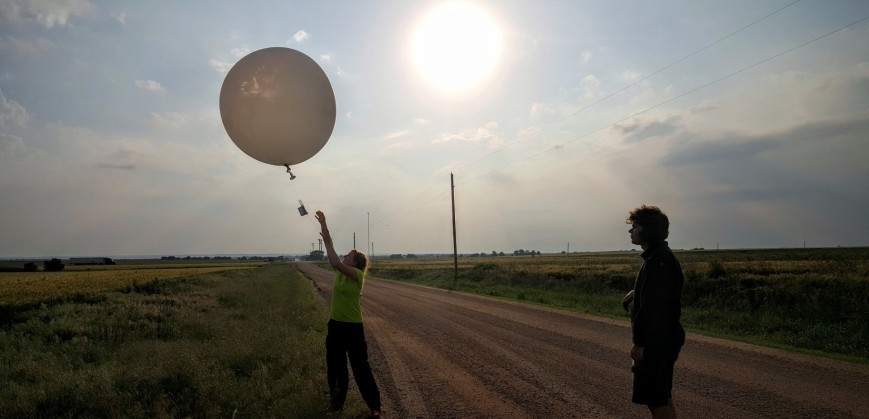Why do thunderstorms strike at night?
by Kate Jeracki | June 10, 2015 4:39 PM

CSU graduate students Stacey Hitchcock and Greg Herman launch a weather balloon near sunset in Kansas as part of a massive research project to help understand how thunderstorms form at night. Photo courtesy Russ Schumacher
The abundance of rain in Colorado this spring — and the powerful tornado that touched down near Berthoud this month — has lots of people thinking about storms. A group of scientists, including CSU’s Russ Schumacher, are literally staying up nights thinking about thunderstorms, and what they find may ultimately help improve forecasts of these potentially damaging weather events.
From June 1 through July 15, researchers from across North America are fanning out each evening across the Great Plains, where storms are more common at night than during the day.
The Plains Elevated Convection at Night (PECAN) field campaign involves scientists, students and support staff from eight research laboratories and 14 universities, including CSU, University of Wyoming, National Oceanic and Atmospheric Administration, National Center for Atmospheric Research, and the Center for Severe Weather Research. They use lab-equipped aircraft, ground-based instruments and weather balloons to better understand the atmospheric conditions that lead to storm formation and evolution after sunset.
“In the central U.S. in the spring and summer, a large fraction of the rainfall actually occurs overnight. Despite these nighttime storms producing a lot of the agriculturally beneficial rainfall in the Plains, there’s a lot we still don’t know about storms that occur at night,” Schumacher said. “There’s never really been a field project focusing on nocturnal storms, and with the wide array of instruments taking part in PECAN, we have a prime opportunity to really advance understanding and prediction.”
The $13.5 million project is largely funded by the National Science Foundation, which contributed $10.6 million. Additional support is provided by NASA, NOAA, and the U.S. Department of Energy.
Thunderstorms that form during the day are less puzzling than nighttime storms.
The typical afternoon thunderstorm forms when the sun heating the earth leads to instability in the atmosphere as warm surface air meets cooler air aloft. Often storms initially develop over the high terrain in Colorado and Wyoming in the afternoon and evening, and then move eastward into Kansas and Nebraska after sunset.
But that process shifts overnight as the surface cools, Schumacher explained, and other processes can maintain that instability overnight. Sometimes very intense storms can persist all the way until the next morning, creating a threat for severe weather and flash flooding.
“We don’t fully understand a lot of those processes, and that’s why we want to take these observations in the field,” he added.
Related Story: Ever wondered how far was that lightning[1]?
A fleet of instruments
PECAN uses three research aircraft, two of which fly in clear air away from storms. Only the third, a NOAA P-3, which is widely used in hurricane research and reconnaissance, will be able to fly into the trailing regions of storms.
The researchers also rely on a number of ground-based instruments, known as PECAN Integrated Sounding Arrays, or PISAs. Six PISAs will operate from fixed locations around the study area and four will be mobile, allowing them to be repositioned each night depending on where storms are expected to form.
The instruments within each PISA vary, but collectively they give each array the ability to measure temperature, moisture and wind profiles, as well as launch weather balloons.
The scientists also have a fleet of mobile and fixed radars. In all, PECAN researchers will have access to more than 100 instruments brought to the effort by partner institutions.
The vast array of instruments allows PECAN researchers to collect data higher in the atmosphere, which will help them characterize the conditions that lead to individual storm formation as well as to the clustering and organizing of these storms into large-scale systems.
The PECAN campaign, based in Hays, Kan., begins each day at 8 a.m. when a crew of forecasters starts developing a nightly forecast.
At 3 p.m., the scientists will use the forecast to determine where across northern Oklahoma, central Kansas or south-central Nebraska to deploy their mobile resources for the coming night.
That’s why Schumacher was in Kansas on June 4, when the first EF-3 tornado in Colorado since the Windsor tornado in 2008 touched down near Berthoud. He followed it remotely, however.
“The unusual aspect about the Berthoud tornado was that it was moving westward toward the Front Range, and occurred so close to the mountains,” he said. “From what we can find in the records, this is the first time that an EF-3 or stronger tornado has occurred west of I-25 in Colorado, although a couple have occurred that far west in southern Wyoming.”
The early-evening tornado struck Berthoud at a fairly typical time, Schumacher added. The Windsor tornado was the anomaly, forming before noon.
- how far was that lightning: https://source.colostate.edu/how-far-away-was-that-lightning/
Source URL: https://source.colostate.edu/why-do-thunderstorms-strike-at-night/
Copyright ©2024 SOURCE unless otherwise noted.